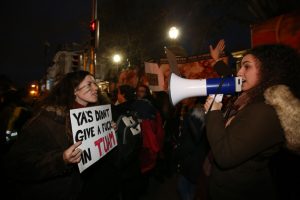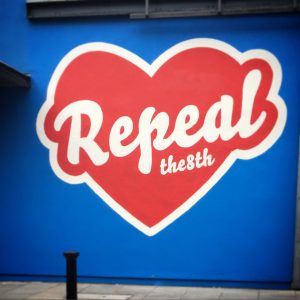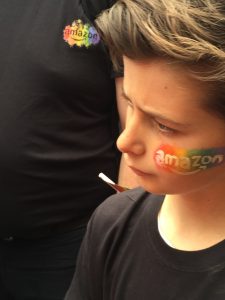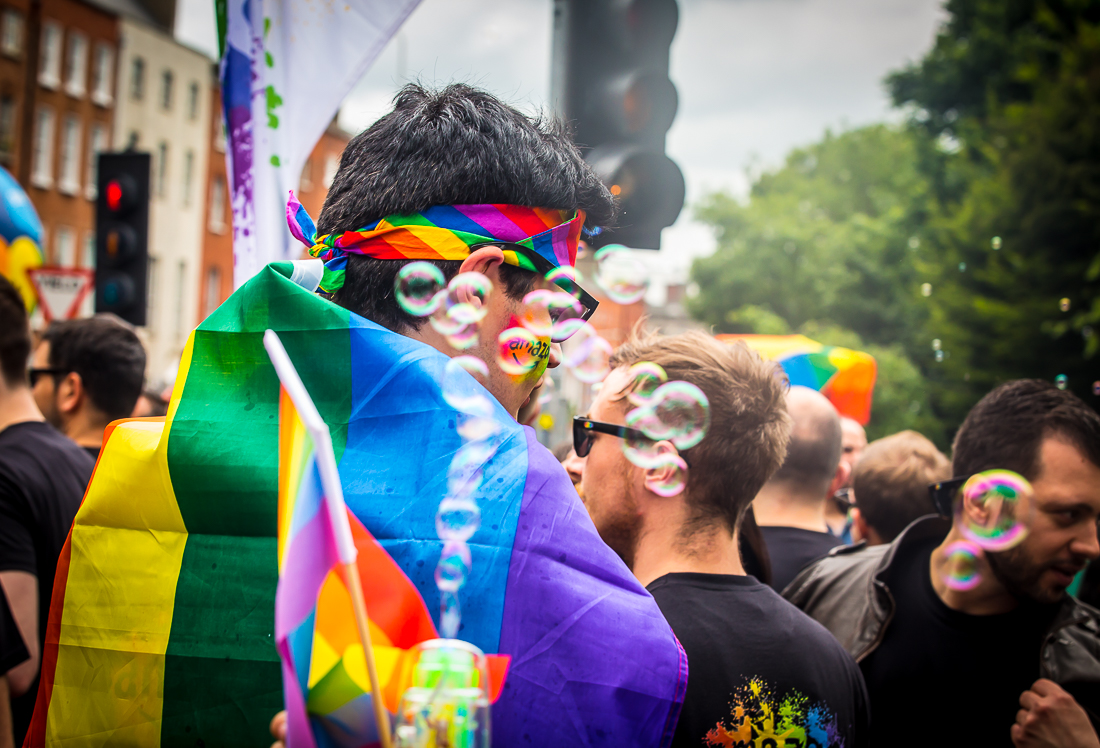So I thought I’d ease you back into reading the blog by starting with this: the fraught issue of the health and well-being of women and children in historical and contemporary Ireland in relation to medical, educational and social services as provided by the Catholic Church.
Are you feeling more relaxed already? Good.
A lot of people here are not feeling relaxed at present and here’s why. The National Maternity Hospital, the busiest in Ireland and famous as the birthplace of Amy, needs bigger and better facilities. The proposed new site is an existing hospital campus owned by the Sisters of Charity, and this is where it gets interesting. The hospital will cost €300 million of taxpayer money and ownership will be handed over the the Sisters because they own the land and founded the hospital already on the campus.
The Sisters of Charity ran some of the infamous Magdalene Laundries which, according to a 2013 report investigating abuse that took place, were guilty of the ‘enslavement’ of an estimated 30,000 women and children until the last one closed in 1996. The facts are well established and are not under debate: they were workhouses in which women and girls were imprisoned, often without knowing why and always without knowing when or if they’d be released. The stories of survivors of the laundries make for harrowing reading.
In 1993 the discovery of a mass grave containing the remains of 155 people on the grounds of a former Magdalene laundry in Dublin led the UN Committee on the Rights of the Child to call for a government inquiry into what took place in the laundries. As a result, in 2013 the State issued a formal apology to survivors and families of victims and set up a €60 million compensation scheme. Despite repeated calls by the government and the UN Committee Against Torture, the Catholic Church has refused to contribute to this fund.
In 2002, following a separate investigation into child abuse in other residential institutions, the Sisters of Charity were party to a financial redress scheme for abuse survivors. This involved property transfer to the State which has not yet taken place. In 2009 they offered a further €5 million, of which they have paid only €2 million. To put this into perspective, the Sisters of Charity own St Vincent’s Healthcare Group which operates three hospitals and had an income of more than €400 million in 2015. It has a net value of approximately €110 million.
The idea of handing over a hospital built with taxpayer money to a religious order which has reneged on promises of restitution to the victims of the abuse it perpetrated for over 200 years is a problem for the more than 100,000 people who have so far signed a petition protesting it, but it’s not the only one. Not by a long way.
In Ireland abortion is illegal. The only exception is when it is a medical intervention necessary to save the life of the mother. This occurred on 26 occasions in 2014 and the same in 2015, so it’s obviously not being used as a doorway to abortion on demand. However, the exact ruling isn’t clear and as a result Savita Halappanavar, a 31-year-old dentist 17 weeks pregnant with her first child, died of sepsis at University Hospital Galway in 2012 following a uterine rupture which went untreated for several days because there was still a foetal heartbeat. The baby had no chance of survival; the mother could have been saved. There were protests in the streets. There have been cases of women dying after being denied cancer treatment while pregnant. It doesn’t happen often, but it happens.
I’m glad I didn’t know that this was a possibility when I was pregnant here in 2002. Can you imagine, in this day in age, in a developed country, being pregnant and knowing that if something happens – a uterine rupture, an ectopic pregnancy – you could go to a University Hospital – a reputable, brainy, modern-sounding place – where they would watch you die rather than risk hurting a foetus that has zero chance of turning into a surviving baby? Because this is a Catholic country and Catholics are pro-life?
Well, many of the people of Ireland aren’t too thrilled with this state of affairs either. So when it became public knowledge that their tax euros, all €300 million of them, would be spent on a hospital to be given into the ownership of a religious order who not only haven’t paid their torture bills but are also dead set against not only terminations in any form but also IVF, sterilisations and gender-reassignment surgeries, all hell broke loose.
The boss of the National Maternity Hospital has repeatedly said that although the Sisters of Charity would own the place, and would sit on the Board, the running of it would be completely independent and the nuns would have nothing to do with the medical side of things, but it’s not good enough. What I see, what’s very plain to see, is that there is a huge, deep seam of pain and betrayal that runs through the Irish collective memory, and it’s not very far from the surface at all.
This, I’ve decided, is the real issue behind the current movement around abortion law reform. The 8th Amendment, the current law, places equal importance on the lives of the mother and the baby, meaning that one cannot choose to terminate the other even in cases of rape, incest or fatal foetal abnormality. Each year thousands of women travel to the UK and other European countries for terminations. and there is a rising tide of dissatisfaction with this state of affairs.
On March 8th, International Women’s Day, the centre of Dublin was filled with people demanding a re-think of the state’s abortion laws:
It’s about more than wanting to be able to access a termination without having to leave the country. It’s about the fact that from 1922 when the Irish Free State was formed it has been run in practical, day-to-day terms not by the Irish Government but by the Roman Catholic Church, and their attitude towards women and children has been one of hatred and brutality. It’s not just the laundries but the mother-and-baby homes, the orphanages, the industrial schools, the paedophile clergy, the asylums for people with disabilities, the symphysiotomies. If you don’t know what a symphysiotomy is, don’t Google it because it comes into the category of things you’ll wish you could un-know. It was a horrific and crippling medical procedure used not for the health or well-being of mother or baby but to make sure that the mother could continue to have as many children as possible, and it ruined many lives, and you don’t want further details, believe me.
There have now been wide-ranging investigations into all the above and they paint a picture of generations of women and children traumatised, marginalised, stigmatised and abused because women were seen as breeding stock (although sex was sinful) and children seen as brownie points to please God. Priests were all-powerful and the Church dominated Irish life. If you doubt the scale, if you think I’m exaggerating, ponder this: the State inquiry into abuse in church-run institutions incurred €1.5 billion in redress costs. One and a half billion euros. To date the Catholic religious congregations who ran the institutions where children were abused have paid just 13% of their portion, although they all own properties and run businesses turning over multi millions.
Now, however, people are finding their voices. People are starting to say, why would we trust you to make decisions for us? Why would we put our health in your hands? Why do you get to legislate around reproductive rights when you’ve been treating women and children with, literally, criminal negligence for hundreds of years? The young women of Ireland are standing up and saying:
People are saying, don’t tell me that I can’t choose an abortion because we’re pro-life when you were running mother-and-baby homes where infant mortality rates were known to be horrifically high and where staff were running a lucrative illegal trade in baby-selling to rich Americans. Don’t tell me that watching a mother die of sepsis because a non-viable foetus had a beating heart for a few extra days makes you qualified to tell me what God thinks of me. Don’t tell me anything.
It seems to me that Ireland is in the early days of a revolution in terms of demanding the separation of church and state. There is dissatisfaction with the fact that most children get a Catholic education or none at all. Over 90% of schools are Catholic and the others have huge waiting lists. I know because we tried them. Of the non-Catholic schools the vast majority are still faith schools; if you want a secular education for your child here you have 3% of the schools in the country to choose from.
People do not hate Catholicism. Every weekday morning the carpark at our local church, Our Lady of Victories, is full in time for 9 o’clock mass. It’s mostly the Nissan Micra and Toyota Yaris brigade, but still. Catholicism is part of the national identity; it was so important after 1922 because it set the Irish apart from the British, and it still is. But lots of people are saying quite loudly that they want it to stay contained within churches. They want to go to hospital knowing they’ll be treated in accordance with medical best practice, not with the moral edicts of a particular religious denomination. They want to send their children to school knowing that they will not be proselytised; that if their choice is athiesm or agnosticism or anything else, it will be respected.
Plenty of people still love and support the church, they just want its power limited. The whole argument is summed up nicely here:
Recently the remains of 796 babies were found in a septic tank on the site of a former mother-and-baby home run by the Bon Secours nuns in Tuam, County Galway. Nobody knows (or is admitting to knowing) whether it was used as a septic tank at the time the babies were put there or whether it was simply a handy large empty space. It doesn’t really matter, though. If you put dead babies in their hundreds in a septic tank you don’t get to claim the moral high ground on anything, ever. And you certainly don’t get to claim to be pro-life.
Next time there will be fun stuff and pretty pictures, I promise.









































